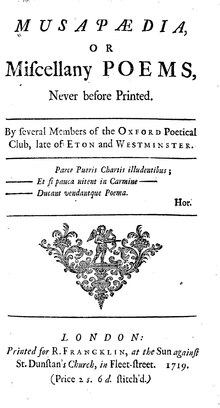
A miscellany is a collection of various pieces of writing by different authors. Meaning a mixture, medley, or assortment, a miscellany can include pieces on many subjects and in a variety of different forms.[1] In contrast to anthologies, whose aim is to give a selective and canonical view of literature, miscellanies were produced for the entertainment of a contemporary audience and so instead emphasise collectiveness and popularity. Laura Mandell and Rita Raley state:
This last distinction is quite often visible in the basic categorical differences between anthologies on the one hand, and all other types of collections on the other, for it is in the one that we read poems of excellence, the "best of English poetry," and it is in the other that we read poems of interest. Out of the differences between a principle of selection (the anthology) and a principle of collection (miscellanies and beauties), then, comes a difference in aesthetic value, which is precisely what is at issue in the debates over the "proper" material for inclusion into the canon.[2]
Manuscript miscellanies are important in the Middle Ages, and are the sources for most surviving shorter medieval vernacular poetry. Medieval miscellanies often include completely different types of text, mixing poetry with legal documents, recipes, music, medical and devotional literature and other types of text, and in medieval contexts a mixture of types of text is often taken as a necessary condition for describing a manuscript as a miscellany. They may have been written as a collection, or represent manuscripts of different origins that were later bound together for convenience. In the early modern period miscellanies remained significant in a more restricted literary context, both in manuscript and printed forms, mainly as a vehicle for collections of shorter pieces of poetry, but also other works. Their numbers increased until their peak of importance in the 18th century, when over 1000 English poetry miscellanies were published,[3] before the rise of anthologies in the early 19th century. The printed miscellany gradually morphed into the format of the regularly published magazine, and many early magazines used the word in their titles.
- ^ Miscellany, n. OED Online. Oxford University Press. Retrieved April 18, 2013.
- ^ Laura Mandell and Rita Raley, Anthologies and Miscellanies (1997; last revised 2002). Retrieved April 18, 2013.
- ^ "About", Digital Miscellanies Index